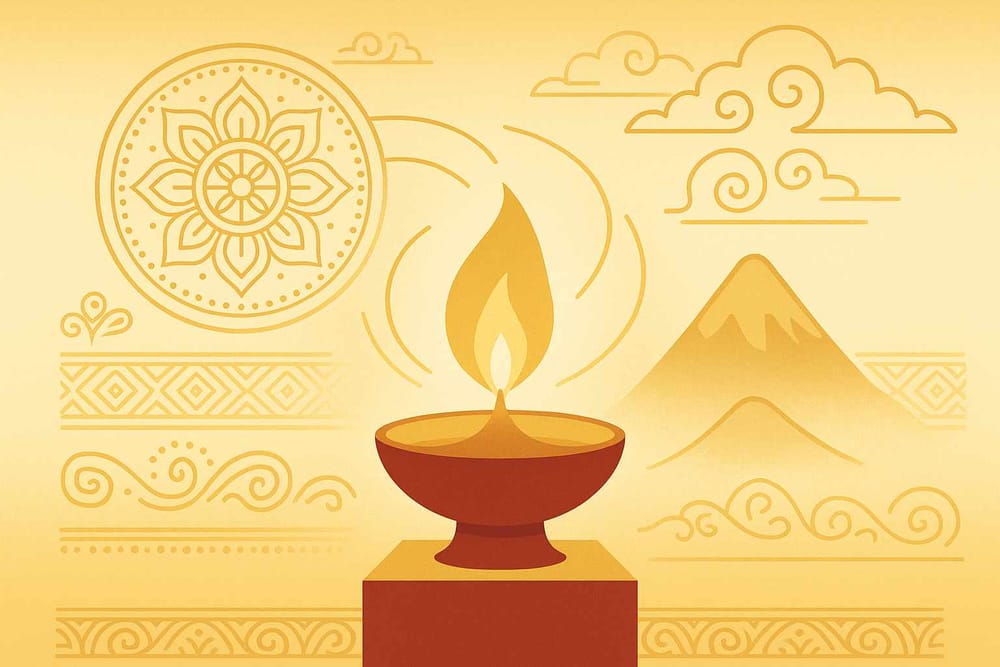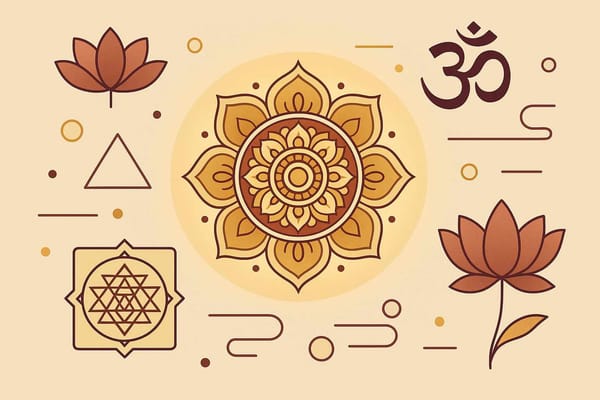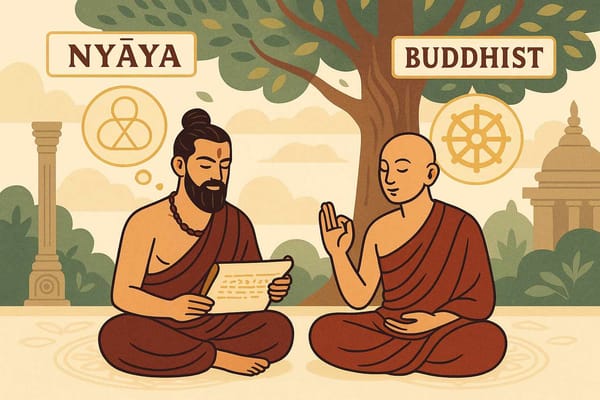
Vyapti and Linga in Indian Logic: A 2025 Guide
Have you ever looked at dark, heavy clouds gathering in the monsoon sky and just known, deep in your bones, that it’s about to rain? Or smelled the sweet, earthy fragrance of wet soil—sondhi mitti—and felt a sense of joy and relief? That certainty, that instinctive connection between a sign and what it signifies, isn’t just a random guess. It’s a beautiful, inbuilt logic that our ancient Indian rishis and thinkers explored and perfected for centuries. They gave this profound understanding special names: Vyapti and Linga.
It sounds complex, I know, but trust me, it’s something we live and breathe every single day. Let's unravel this ancient wisdom together, and you'll see how it’s not just philosophy locked away in old books, but a living, breathing part of our world.
The Unbreakable Bond: Understanding Vyapti and Linga Together
Imagine you are looking at a distant hill. You see a plume of smoke curling up into the sky. Immediately, your mind says, “Ah, there must be a fire.” How do you know this? You haven't seen the fire itself, only the smoke. This is where the magic of Vyapti and Linga comes into play.
- Linga: The Observable Sign (The Smoke): In our ancient logic, the Linga is the sign, the mark, the evidence you can see. It’s the smoke rising from the hill. The word ‘Linga’ itself means a symbol, and in this context, it’s a symbol that points to a deeper truth. It’s the clue that starts the entire process of knowing.
- Vyapti: The Universal Truth (Smoke Means Fire): Now, the sign (smoke) is useless unless it’s connected to a universal, unbreakable rule. This rule is Vyapti. Vyapti literally means ‘pervasion’—it’s the knowledge that one thing is invariably connected to another. It’s the universal truth that “wherever there is smoke, there is fire.” This isn't just a one-time observation; it's a constant, reliable relationship that has been seen again and again, in the kitchen, in a havan, or in a forest.
So, Linga is the immediate observation, and Vyapti is the deep, underlying wisdom that gives that observation meaning. They are two sides of the same coin, working together to help us understand the world beyond what our eyes can see. This process of arriving at knowledge through signs and universal rules is what our philosophers called Anumana, or inference.
Diving Deeper: The Wisdom of Our Sages in the Nyaya Sutras
Our ancestors didn't just stumble upon these ideas; they debated, refined, and systemised them with incredible precision. The great sage Gautama, in his foundational text, the Nyaya Sutras, laid out the framework for this logical reasoning. He knew that for an inference to be correct, the relationship had to be foolproof.
The Nyaya school taught us that this connection, this Vyapti, must be absolute. They even explored different kinds of connections:
- A Positive Connection (Anvaya): This is the simple one we’ve been discussing. Wherever the sign is present (smoke), the thing it signifies (fire) must also be present. It affirms the relationship.
- A Negative Connection (Vyatireka): This is just as important. It says that wherever the thing signified is absent (no fire), the sign must also be absent (no smoke). Think of a cold, clear lake—there is no fire, so naturally, there is no smoke. This dual confirmation makes the reasoning rock-solid.
It is this deep-seated logical framework that forms a core part of many Hindu rituals and philosophies, ensuring that faith is accompanied by profound understanding. The Mimamsa school, for instance, used this logic to interpret Vedic rituals, arguing that the rituals (Linga) were signs that pointed to a desired outcome (like a good harvest or well-being) based on the established Vyapti in the holy texts.
Is This Ancient Logic Still Alive Today? Absolutely!
It's easy to think of these as dusty old concepts, but the truth is, the wisdom of Vyapti and Linga is woven into the fabric of our modern lives. We just use different words for it.
Think about a doctor diagnosing an illness. The symptoms—a fever, a cough, a rash—are all Lingas (signs). The doctor connects these signs to a diagnosis based on their medical knowledge, which is a form of Vyapti—an established, universal relationship between certain symptoms and a specific disease. It’s a direct application of ancient Indian logic!
Even in the world of cutting-edge technology like Artificial Intelligence, the core principle is the same. AI algorithms are trained on vast amounts of data to find patterns (Lingas) and establish correlations (Vyapti) to make predictions. The spirit of the Nyaya Sutras is alive in the most advanced labs in the world.
From a lawyer presenting evidence (Linga) in court based on legal principles (Vyapti) to our own everyday decisions, this way of thinking is everywhere. It shows how our ancestors weren't just spiritual masters but also masters of reason and logic.
A Path of Devotion and Understanding with Bhaktilipi
Understanding these deep concepts helps us appreciate the incredible intellectual heritage we come from. It gives us a new lens to view not just the world, but our own traditions and practices. Why do we perform certain rituals? What is the inner meaning behind a particular symbol?
At Bhaktilipi, we are passionate about exploring these questions. We believe that true devotion blossoms when the heart's faith is supported by the mind's understanding. Our platform is a space to delve into timeless devotional literature and stories, explained in a way that connects with our lives today.
If you're curious to explore more about the profound wisdom contained within our Hindu scriptures and practices, we invite you to join our community. Discover the logic behind the rituals and the stories behind the symbols.
We craft every piece of content with reverence and care. For more inspiring stories and spiritual insights, subscribe to our newsletter and follow us on Facebook, Instagram, and our YouTube channel. Let's walk this path of knowledge and devotion together.
Conclusion: The Timeless Dance of Sign and Substance
Vyapti and Linga are more than just philosophical terms; they are a testament to the harmony of observation and wisdom. They teach us to look closely at the world around us, to see the signs, and to connect them to the universal truths that govern our existence. This beautiful dance between what we see (Linga) and what we know (Vyapti) is the very essence of understanding.
By honouring this profound legacy of Indian logic, we not only connect with our roots but also equip ourselves with a powerful tool for clear thinking in our complex modern world. It is a reminder that our tradition is both deeply spiritual and brilliantly logical, a heritage truly worth celebrating.
A passionate group of people dedicated to preserving India's knowledge of Dharma, Karma, and Bhakti for ourselves and the world 🙏.
Comments
Related in

Exploring the Depths of Indian Logic and Metaphysics - A 2025 Guide
Have you ever looked at the world around you and felt a deep, nagging question bubble up from within? A question about what is truly real, beyond what our eyes can see? This feeling, this curiosity, is not new. It's a sacred inquiry that our ancestors in India

Indian Logic - Nyaya and Buddhist Perspectives: A Deep Dive
Have you ever been in a heartfelt discussion with a friend, trying to explain your point of view with perfect logic? That feeling of wanting to arrive at the truth, to present your case so clearly that it can’t be denied – it’s a deeply human instinct. What if
